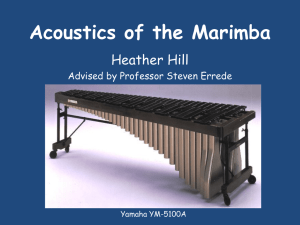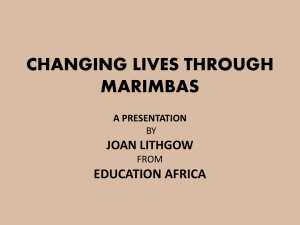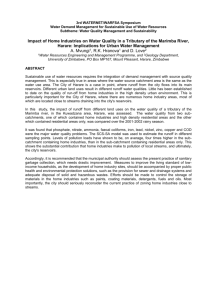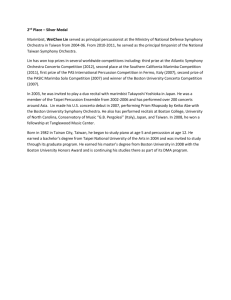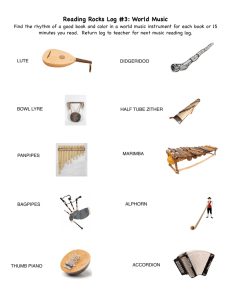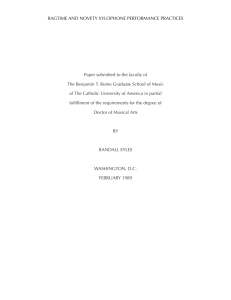The Marimba of Mexico and Central America
advertisement
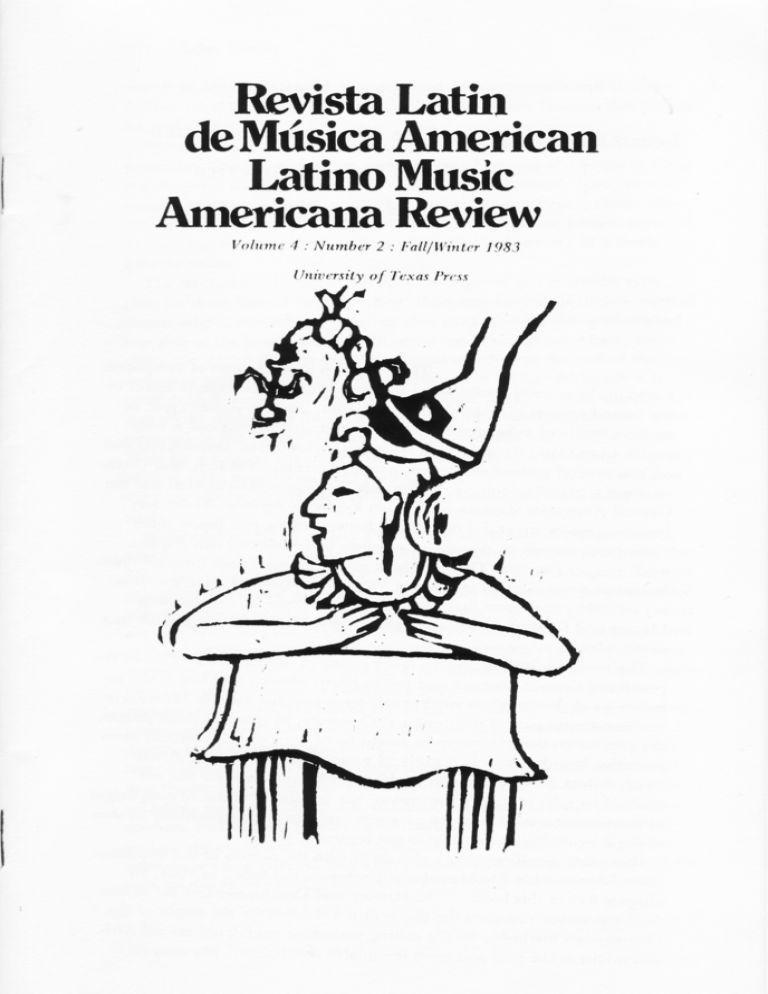
Robert Garfias The Marimba of Mexico and Central America There are two distinct types of xylophone found in the musical traditions of the New World. One type is found in the coastal regions of Colombia and Ecuador, and the second type, actually a family of xylophones, is found distributed throughout a wide region from Costa Rica through Nicaragua, Honduras, Guatemala, and on into several regions of Mexico, namely Chiapas, Tabasco, and Oaxaca. Both types of xylophone, that is, the Colombian/Ecuadorian and the Central American/Mexican are known locally as marimba. There are, however, major structural differences between these two types, differences great enough so that they can safely be considered two distinct traditions, or families. There is also a great variety of instrumental types known as marimba in the regions of Mexico and Central America. It is my intention to suggest that all of the variant types of xylophone in Mexico and Central America are generically related, probably back to a single African origin. The marimba has become so much a part of the culture and life of the peoples of Central America and southeastern Mexico that few of the inhabitants of these regions would consider it possible that the instrument was not always part of their culture. Certainly, to many of these people, the suggestion that the marimba might be of African origin would seem patently absurd. There is a study of some depth by Marcial Armas Lara, in fact, that purports to establish a Mayan origin for the marimba.’ In spite of Lara’s contention, the possibility of the Mayan origin of the marimba is, at best, an extremely remote one, particularly in view of the overwhelming evidence to the contrary. One other significant work also deals with the origins of the marimba: Vida Chenoweth’s The Marimbas of Guatemala, published in 1964. In chapter five of this book, “The History and Development of the Marimba,” the author discusses the different possibilities for the origin of the Guatemalan marimba, finally resting with most confidence on tile African origin as the best and most reasonable conclusion.’ My own research in Mexico, Central America, and Africa supports and perhaps further substantiates Chenoweth’s arguments on the Guatemalan marimba. My own research is far from complete, and there always exists the possibility that in some as yet undocumented regions of Mexico or Central America additional evidence may still be uncovered. I am, nevertheless, firmly convinced, on the basis of existing evidence, of the African origin of the Mexican/Central American xylophone known as marimba and, further, that these various types of xylophone are of a single generic origin. The strongest evidence of the African origin of this marimba type rests on three factual elements: first, the name marimba is itself a word of Bantu origin; second, the rattan or thin strip of wood that goes around one side of the instrument is commonly used throughout Africa; and third, the use of the vibrating membrane attached to the wall of the resonator under each key is also widespread in Africa. Although it is possible that any one of these elements might have occurred simultaneously in Africa and the New World, the existence of all three of these elements in the New World and in Africa presents too strong an argument for a historic connection to be swept aside as coincidence. Chenoweth touches on each of these points, along with other facts concerning the connections between the African xylophone and Guatemalan marimba. Before discussing in greater detail the three points of comparison, which I regard as providing the most conclusive evidence relative to the relationship of the Central American/Mexican marimba and the African xylophone with calabash resonators, I should like to give my reasons for not pursuing some of the other facts Chenoweth gives. At various points she mentions similarities and differences in the scale and tuning systems of these American and African xylophones. Although precise pitch measurement techniques are available, it is difficult to use similarity in pitch intervals as an element of continuity between these cultures for two reasons. First, pitch references are given in rough Western-tempered approximations and therefore cannot serve as tangible scientific evidence. The Chopi timbila tunings, for example, in fact bear very little resemblance to the Western-tempered system. Second, it is my opinion that the necessity of adapting to the current or local vocal melodic type primarily motivates changes in instrumental tunings, and, again in my opinion, that tunings exhibit rapid change over time and across geographic distances and therefore make only a weak argument for the substantiation of cultural ties. Here, of course, I am speaking only of the tunings themselves and not any theory of tuning that might be transmitted. However, there is no evidence of such theoretical musical connections between African xylophone music and Central America. In talking about structural connections between the African and American xylophones, Chenoweth refers to the mallets. Here I would suggest that, if the African and American mallets shared some unusual feature, such as the use of forked handles, or if they were curved, or angular, then perhaps an argument could be made. However, straight wooden mallets with soft or padded beaters are far too universal to serve as a possible focus of cultural connection. Chenoweth does, however, also mention the fact that, in the older form of the marimba con tecomates or marimba de arco, the keys of the instrument were more oval than rectangular, as they commonly are today (Chenoweth, p. 30). This oval key is also common in certain types of African xylophones (see, for example, the xylophone from the Central African Republic, drawing 4). The use of these oval keys might also strengthen the possibility of a geographically precise cultural connection. Let me now return to the three points that I regard as having primary importance in this argument. The word marimba is related to a number of words in Bantu languages, all referring either to a xylophone or to some other musical instrument, such as one of the various types of lamellophone, or mbira, and, by extension, to musical sound in general. In the Bantu language systems, therefore, the words marimba, mbira, or even likembe are all considered variants of a common word root. Among the various names for xylophone in Bantu-speaking Africa one finds, besides marimba itself, silimba or sirimba, timbila, and amadimba, or madimba. The syllable ma functions as a prefix that usually signifies plural, and the root of the word signifies a musical sound. Although it is not possible now to say precisely from which African xylophone type or from which region of Africa the Mexican/Central American marimba may have originated, the linguistic evidence suggesting that the name marimba is of African, specifically Bantu, origin is conclusive. It should also be noted that names for the xylophone that sound like marimba are more common in Central, East, and South Africa than in West Africa, although the largest proportion of slaves brought to the New World came from West Africa. The second element linking this American xylophone to Africa is the long strip of wood extending along one side of the instrument. Although there are many types of xylophone to be found in Africa, a large number of these do use this strip of wood along one side. The appearance of this strip of wood cannot be used to pinpoint the exact origin of the marimba in Africa, since this element is to be found in several geographic regions of Africa. The strip of wood, often the long, straight branch of a tree, serves a number of functions. It can form a brace for the instrument, with the strip of wood placed on a stump of wood and the player sitting on both while hooking his legs inside the strip and thereby balancing and stabilizing the instrument as he plays. It can serve as a convenient handle when carrying the instrument. Furthermore, when the instrument is played from a standing position, it is suspended from the neck, and the strip allows the keys to vibrate freely by preventing them from coming into contact with the player’s body. All of these functions are noted with frequency throughout Africa south of the Sahara, but only the first two appear regularly in Mexico and Central America. Chenoweth draws attention to this strip or arc of wood as a point of similarity between both types of xylophone. She mentions both the Congo type (see drawing 1) and the Chopi timbila (see photo 2), noting that the timbila has an angular handle or brace. The timbila does in fact represent a somewhat unique departure from the simple arc used in most other parts of Africa. Whereas the arc is very widespread throughout Africa and whereas it is not possible to use its existence to identify a single point of origin in Africa for the American marimba, it is also clear that, because of the unique type of arc the Chopi in Mozambique use and because of the absence of this type of arc in America, the Chopi timbila was probably not the type introduced to America. African xylophones exist in several forms. A broad distinction can, however, be drawn between those that use a common resonator for all the keys or no resonator at all other than the space between the keys and the ground itself, and those instruments that use an individually tuned resonating chamber for each key. These individual resonating chambers are usually made of calabash. The Mexican and Central American marimba is of this second type. This type of xylophone with individual resonating chambers is, once again, found throughout Africa south of the Sahara, from Senegal to Mozambique. In addition to the use of these resonating chambers for each key, a small hole cut in the wall of each calabash and a vibrating membrane stretched over this hole to produce a desired buzzing or humming sound is a very general characteristic. In certain African xylophones, the timbila of the Chopi and the Royal Nkoya xylophones of Zambia, for example, the vibrating membrane is not stretched directly over a hole in the calabash. It is instead stretched over a small circular plug, which protects the membrane. The entire plug is inserted into a hole in the calabash resonator. In Africa, the membrane is most frequently made of the thick part of the web wall of a ground spider. The web is stretched over the hole made in the resonator and fixed in place and protected with a small ring. In the Americas this vibrating membrane is most often made of the intestines of a pig or monkey. The buzzing sound is a characteristic of almost all African musical instruments and is, in most other types of instruments, achieved by the addition of bits of shells or small pieces of metal, which vibrate whenever the instrument is sounded. Although there are some instances, for example, in Senegal, in which metal pieces are added to increase the buzzing quality during performance, the vibrating membrane on the resonating chamber is much more common and, in fact, practically universal in Africa wherever there are xylophones with calabash resonators. Even the balafon of Senegal has these vibrating membranes attached to each resonator. The ringing sound is added by having the players wear little bells on their wrists. Although there are many distinctive instruments called marimba in Mexico and Central America, they all share certain characteristics: wooden keys, resonating chambers for each key, and a vibrating membrane for each resonator. Many also use the wooden strip as a carrying handle or brace. Variations in structure are numerous, Some have only the seven-note diatonic system while others may use the twelve-tone chromatic system and double keyboard. Some marimbas are played by a single player and others require three or four players on a single instrument. Some of the American marimbas still use calabash resonators, some use bamboo or cane, and some even use wooden resonators carved to resemble calabash or bamboo. It is interesting that in Masaya, Nicaragua, these resonators are usually made of wood carved to resemble a calabash, but that the local musicians say they remember when the resonators were usually made of cane or bamboo. Several investigative visits to Mexico and Central America have not revealed definitive evidence that would indicate the point at which the marimba was introduced from Africa. It is ironic and intriguing to note that the region of America where marimbas of the most distinctive African type are to be found in greatest abundance is one of the regions that would appear to have been most remote from possible African points of contact, that is, the highlands of Central Guatemala. However, I believe that it is important to keep in mind the distinction between an area where such an instrument might have first been introduced and the area where it may later have flourished and developed, Great numbers of Africans were brought as a labor force to Central America and to parts of Mexico. Although strong indications of the presence of Africans are still evident along the Gulf Coast of Central America, historical evidence indicates that a great many African slaves were brought to the Pacific Coast of Central America as well. These slaves formed, with the Indians, the basic labor force of the coastal areas of Central America. It is possible and most likely that in some such coastal area the idea, form, and structure of the African marimba was transmitted to the Indians of the region. It is clear that the instrument spread effectively among the Indians of the entire region of Central America to Guatemala and Chiapas, with its greatest development probably occurring in Guatemala. However, since it is impossible to know precisely from which region of Africa the marimba came to America, or precisely to which region of America it was first introduced,, it is also impossible to have any idea of how the first marimba music of America might have been played and whether any African musical influences might have been transferred along with the instrument itself. Although there are a number of regions on the coast of Central America where the marimba might have been introduced from Africa, one possibility might have been Guanacaste, a long coastal area in the northwest region of Costa Rica that extends along the southwestern region of neighboring Nicaragua, the area around the city of Masaya. There is historical evidence of the existence of African slaves as part of the labor force here, and, perhaps even more important, marimbas with calabash resonators and the strip of wood used as a brace or handle are still to be found extensively throughout this region. Although the existence of this evidence for Masaya and Guanacaste does not preclude the possibility of the introduction of the marimba at some other point of coastal Central America, this area of Nicaragua and Costa Rica does clearly represent a distinct possibility.” From such a potential point of contact the African marimba might have been passed along from one Indian group to another until it finally reached the highlands of Guatemala. What is important to note is the fact that the marimbas played in the highlands of Guatemala, as well as those found in southwestern Nicaragua and northwestern Costa Rica, still have today the strongest structural similarities to the African xylophones. Manuel B. Trens, in his Historia de Chiapas, after stating that in his opinion the marimba cannot have been of indigenous origin, gives his reasons for believing that Africans introduced it into Chiapas.’ He goes so far as to suggest that slaves from Santo Domingo (Dominican Republic), who were brought to establish a breeding area for African slaves, introduced the marimba to the area of Chiapas bordering on coastal Guatemala. There is no doubt that the African xylophone could easily have been introduced to the Pacific Coast of Chiapas or Guatemala. The appearance of a prototypical marimba con tecomates, although not conclusive in itself, might do much to substantiate such a possibility. Until additional research in coastal Chiapas and Guatemala is conducted, this region, like that of coastal Nicaragua and Costa Rica, will have to remain one more conjectural possibility. Nonetheless, Guatemala was an important region for the development of the marimba. There was cultural contact at the end of the colonial period between Guatemala and northwestern Costa Rica. Although the term marimba was certainly already well established in this area of Costa Rica, for the first time the terms marimbero and marimbista came to be used as a result of this contact with Guatemala.’ There were three broad ethnic/cultural forces involved in the development of the marimba in America: the indigenous, the European, and the African. Although each of these cultural elements certainly had many important variants and subcultures, even considered in broadest terms, their major impact can be sensed. It would appear that of the African cultural element nothing may remain, although it is worth noting here that the marimba tradition of Colombia and Ecuador is found exclusively among the people of the coastal African cultures. It is also possible that somewhere along the gulf coast of Central America, the marimba may yet be found among one ofthe African communities. Thus, for the Mexican/Central American marimba the strongest and most evident surviving cultural traditions are the Hispanic, or the Hispanicized, and the indigenous. Although there is the possibility that the mestizo and criollo marimba music may have retained and incorporated elements from the Indian cultures, it is even more probable that the Indian playing of the marimba has incorporated elements of the mestizo and Hispanic traditions. Indians play the marimba music of Guanacaste, Costa Rica, and Masaya, Nicaragua; however, these are Indians who today speak only Spanish and their music for the marimba appears to be entirely mestizo/ Hispanic in style and form. The marimba music of western Belize and El Peten of northern Guatemala, as well as the marimba music of Honduras and of central Costa Rica is played by mestizos or criollos, but is largely Hispanic in content as well. It is, however, among the indigenous people of the highlands of Guatemala, in particular around Chichicastenango and also Lake Atitlan that there is a marimba music that appears to be substantively distinct from any European tradition. Since in the highlands of Guatemala this music functions in close connection with the ceremonial life of the Indians, many have supposed it to be autochthonous Indian music. There is, though, no clear Indian model for this music. It is more reason- able to assume that in sonic way it is the result of an adaptation of an indigenous music or a musical concept or principles to the possibilities presented by this new African instrument. It is also possible that the basic technique and style of playing the marimba in Chichicastenango and Atitlan may have been based on an African approach to the playing of this instrument, Just as among the Indians of Chiapas, the basic approach to the technique of playing the harp is based on European principles. In each case, though, the form and content of the music itself may differ greatly from the source of the technique. The harp playing of the Indians of Chiapas is entirely distinct from the European music of the harp, even though the original technical principles were European. If this seems obvious, or if it appears that there might only be one “universally” possible approach to the harp, one need only remember the manner in which the harp is played by the indigenous peoples of the highlands of Peru to be faced with a radically un-European approach to the technique of playing the harp. Whether the marimba as it is played in the highlands of Guatemala retains elements of African culture or whether or not it also incorporates elements of European musical traditions, it is clear that this music is remarkably distinct from the marimba music of Mexico and Central America, whether of other indigenous peoples or of mestizo cultures. This distinctiveness applies both to the playing technique and to the form of the music. In the Chichicastenango region of Guatemala, there are two main compositional types played: la musica de las cofradias and la danza del venado. Each of these compositions, or formal types, is played by a single marimba player and is structured on a repeated bass line over which the player improvises a treble line that varies slightly but constantly for forty-five minutes to an hour. Although the variation form using a repeated ground or bass line was used in Spanish music at the time of the conquest, there is nothing to resemble this technique among the various mestizo/ Hispanic traditions of other parts of Central America or Mexico. It is possible to infer from the various forms in which the instrument survives a potential development pattern for the marimba. Because, to my knowledge, no marimba tradition of African origin survives in Mexico or Central America,’ we must take the marimba of highland Guatemala as probably the oldest surviving form in this tradition as we attempt to reconstruct the pattern of development and diffusion of the marimba in Mexico and Central America. I hypothesize that the marimba, after having been adopted by the indigenous cultures of Central America was gradually adapted to European music as these Indians came increasingly into contact with Hispanic traditions. It is, of course, possible that mestizos or criollos, hearing the Indians playing the marimba, may have decided to take it up and play Hispanic colonial music on it. This seems unlikely, however, if only because this has not occurred with any other instrument or practice in Mexico or Central America. In any case, whether Hispanicized music was first played by Indians or mestizos, it would appear that the next stage in the development of marimba was the playing of the single marimba tuned in approximation of the occidental diatonic scale. The single marimba can be found today as either a solo instrument, as it is in Guanacaste, or accompanied by other instruments like guitars or guitarillos, as it is in Masaya. After this it would seem that mestizos or criollos took up the marimba, replaced the calabash or bamboo resonators with wooden resonating chambers (which could be made and toned with much greater precision), expanded the keyboard to cover four or five octaves (to require several players), and eventually evolved a double or chromatic keyboard. In this form we find marimbas in Guanacaste, in Honduras, both around Tegucigalpa and San Pedro Sula, in lowland and highland Guatemala, as well as in El Peten, in western Belize, and in Chiapas, Tabasco, and Tehuantepec, Oaxaca, Mexico. It would seem that the last development of the marimba, the marimba doble, was a natural expansion of the previous stage. A second, higher pitched marimba was added, to be played by another two or three players. This combined marimba, which required up to seven players, probably was first developed in lowland Guatemala, from whence it spread to the north into El Peten and eventually into Belize, to the west into Chiapas, Tabasco, and Oaxaca, and to the southeast into El Salvador and Honduras. The development of the marimba doble appears to have been quite recent, probably after the turn of the century and to have been expanding and spreading in all directions from a central point.’ Its steady spread during the first thirty or forty years of this century appears to have been interrupted by the rapid developments in mass media communication systems, first radio and later phonograph records disseminated by radio. Notes I . Marcial Armas Lara, Origen de !a marimba, su desenvolvimiento y otros instrumentos musicos (Guatemala City: Tipografia Nacional, 1970). 2. Vida Chenoweth, The Marimbas of Guatemala (Lexington: University ofKentucky Press, 1964). 3. Although there are historical references to the introduction of slavesfrom Africa to this region, today there remains no trace of them. Emel Velasquez, a cattle buyer and transporter from Santa Cruz,Guanacaste, has traveled extensively throughout these areas. In conversations with him during 1975 he assured me that he never saw anycommunities of Africans, or “Jamaiqueños,” as he called them, living along the Pacific Coast of Nicaragua or Costa Rica. 4. Manuel B. Trens, Historia de Chiapas (Mexico City, 1967). 5. Conversations with folklorist Pedro Sanchez in Santa Cruz, Guanacaste, 1975. 6. 1 am here excluding the marimba of Colombia, for the reasons given earlier, although it is strongly African in its traditions. I am also excluding Panama, since I have no first-hand knowledge of this area and have, as yet, uncovered no research that deals with the use of the marimba there. As mentioned earlier, there is also a strong possibility that an African tradition of marimba playing may survive in some region of Mexico or Central America that has not yet been investigated or reported. 7. Chenoweth suggests that the date of the First chromatic marimba may have been as early as 1874. We may assume that the marimba doble appeared after that date (Chenoweth, p. 76). Bibliography Armas Lara, Marcial 1970 Origen de In marimba, su desenvolvimiento y otros instrumentos musicos. Guatemala City: Tipograffa Nacional. Boone, Olga 1936 Les Xylophones du Congo Belge. Annales du Musee du Congo Belge. Ethnographic, Series 3. Caceres, Abraham 1978 “Preliminary Comments on the Marimba in the Americas.” In Discourse in Ethnomusicology.- Essays in Honor of George List, edited by C. Cord, J. Hasse, R. Singer, andR. Stone pp. 225-250. Bloomington: Indiana University Press. Cajigas Langer, Alberto 1961 El folklor musical del Istmo de Tehuantepec. Mexico City: Manuel Leon Sanchez. Chenoweth, Vida 1964 The Marimbas of Guatemala. Lexington: University of Kentucky Press. Garfias, Robert 1971 The Marimba Music of Tehuantepec. 2 LP discs, with notes. Seattle: University of Washington. Trens, Manuel B. 1957 Historia de Chiapas. 2d ed. Mexico City Drawing 3. Xylophone with carrying brace, Cameroons, West Africa Drawing 2. Balafon. Xylophone type from Upper Volta, West Africa (all drawings and photographs are by the author) Drawing 1. Xylophone Bena Kanioka, Congo Tervueren Museum, Belgium Drawing 4. Bagandu xylophone, Central African Republic Chopi Timbila ensemble, Mozambique Chopi Timbila Composer and ensemble leader, Chambini, Mavila, Mozambique Lozi Silimba, Zambia Lobi/Dagarti xylophone, Northern Ghana Masaya Nicaragua. Detail of marimba Marimba, Chichicastenango Guatemala Chichicastenango, Guatemala Detail of Marimba Marimba with metal resonators, Guanacaste, Costa Rica Marimba doble, San Jose Soccotz, Belize Originally published in Latin American Music Review Volume 4: Number 2: Fall/Winter 1983 University of Texas Press
